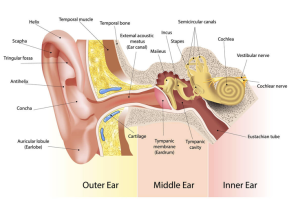CONDITIONS
What is Ear?
The ears are responsible for both hearing and balance. The ear canal has a natural
self-cleansing mechanism wherein earwax and other particles are naturally expelled from the ear canal with jaw movement. Earwax lubricates, cleans, and protects the external auditory canal. Using cotton swabs or any objects to clean the inside of your ear can push earwax deeper or cause injury, ear infections, or even perforation of the tympanic membrane.

Anatomy
The ear consists of three parts: The outer ear, middle ear, and internal ear.
The outer ear includes the visible part known as the pinna, which collects sound waves, and the ear canal, which leads to the eardrum.
The middle ear contains the ossicles (tiny bones) called the malleus, incus, and stapes, which transmit sound vibrations to the inner ear. A narrow eustachian tube connects the middle ear to the back of the throat. The eustachian tube is crucial in equalizing the air pressure within your ears.
The inner ear contains the cochlea and semicircular canals. The cochlea is the organ responsible for hearing, while the semicircular canals, also known as the labyrinthine, play a vital role in maintaining balance.
Functions
Hearing: The process of hearing begins with the outer ear. When a sound occurs outside the ear, vibrations travel through the external auditory canal and reach the eardrum, also known as the tympanic membrane. The eardrum starts to vibrate in response to these sound waves. These vibrations are transmitted to the three tiny bones in the middle ear called the ossicles, amplifying the sound. The ossicles relay the amplified sound waves to the inner ear, specifically to the cochlea, a fluid-filled organ responsible for hearing.
Once the sound waves reach the inner ear, they get transformed into electrical impulses. This conversion takes place within the cochlea. The electrical impulses generated in the cochlea are then transmitted through the auditory nerve, which carries them to the brain. In the brain, these electrical impulses are interpreted as sound, allowing us to perceive and understand auditory information.
Balance: In the inner ear, semicircular canals are filled with fluid and lined with hair-like sensors. When you move your head, the fluid in these curved canals moves and displaces the tiny hairs. These hair sensors then transmit information regarding the movement to the brain through the vestibular nerve. Subsequently, the brain sends signals to the muscles to help maintain balance.



